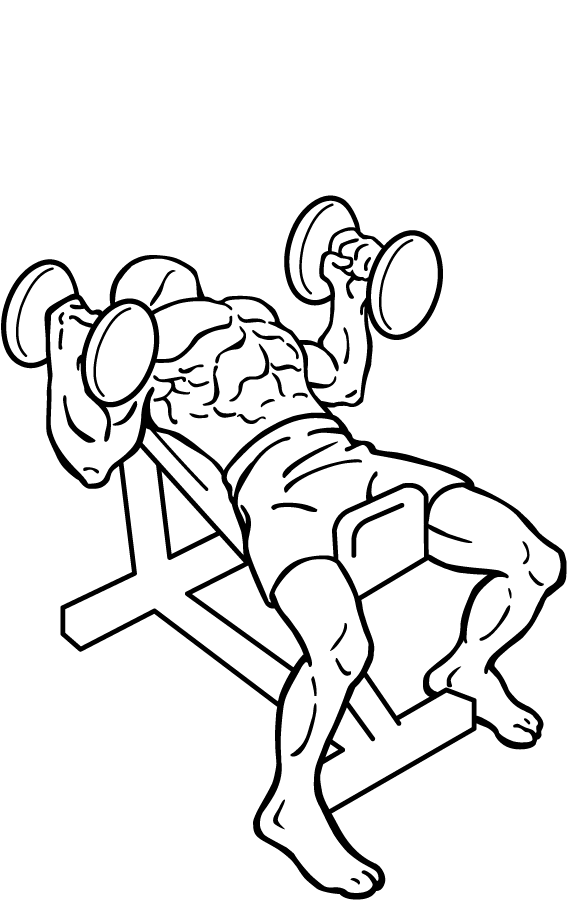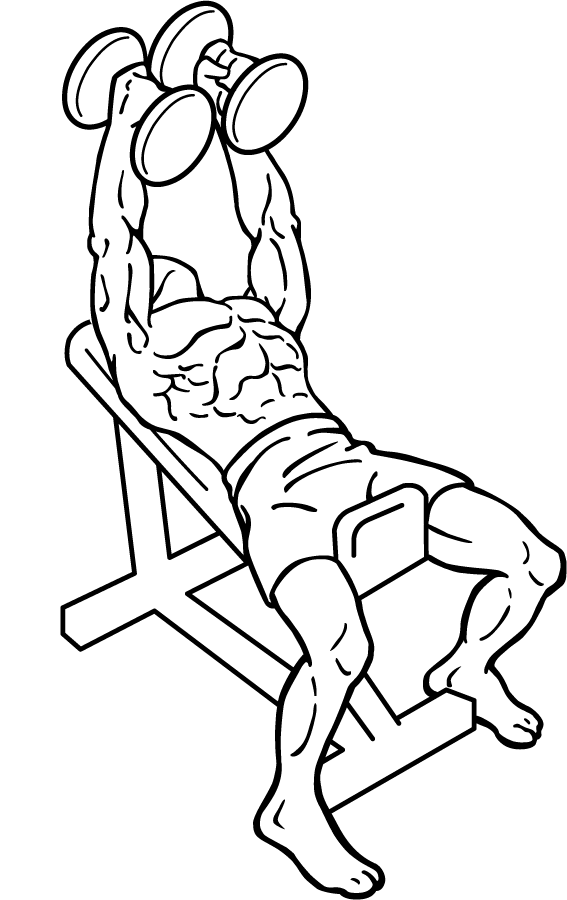Last Updated on September 30, 2022
When it comes to building a powerful upper body, the Hammer Grip Incline Bench Press is a top-tier exercise. This advanced movement targets the chest, triceps, and shoulders, making it a crucial addition to any strength training program. The incline position allows for greater focus on the upper chest while engaging the front deltoids and triceps, resulting in a more defined and powerful upper body.
Incorporating a hammer grip (palms facing each other) not only reduces strain on the shoulder joints but also enhances the range of motion, leading to better muscle activation. Whether you’re a seasoned lifter or transitioning to advanced exercises, the Hammer Grip Incline Bench Press can take your upper body development to the next level.
Why the Hammer Grip Incline Bench Press Is Effective
The Hammer Grip Incline Bench Press offers multiple benefits beyond the traditional bench press:
- Enhanced Muscle Activation: The incline angle (typically set at 45 degrees) emphasizes the upper chest and front shoulders, which are often underdeveloped in standard bench presses. This is especially beneficial for lifters looking to create a balanced, aesthetic upper body.
- Reduced Joint Stress: The neutral (hammer) grip is more shoulder-friendly compared to traditional grips, decreasing the risk of injury while still engaging the chest muscles effectively.
- Improved Range of Motion: The dumbbells provide greater freedom of movement compared to a barbell, allowing for a deeper stretch at the bottom of the press and fuller contraction at the top.
- Functional Strength Development: This exercise enhances stability and functional strength, which is essential for athletes and individuals looking to build practical, usable power.
Step-by-Step Guide to Performing the Hammer Grip Incline Bench Press
To maximize muscle growth and avoid injury, follow these instructions closely. Proper form ensures that you are targeting the intended muscle groups effectively.
- Set Up the Bench and Weights:
- Adjust an incline bench to a 45-degree angle. Ensure that the bench is stable and securely locked to support your weight.
- Select a pair of dumbbells suitable for your strength level. It’s crucial to start with a manageable weight, especially if this is your first time performing this exercise with a hammer grip.
- Position Yourself Correctly:
- Sit on the bench and lean back, ensuring your back is fully supported by the incline bench. Your feet should be flat on the floor, shoulder-width apart for stability.
- Keeping your feet grounded provides a strong base and helps you generate force throughout the movement.
- Engage your core muscles by drawing in your abs. This not only protects your lower back but also enhances overall stability during the lift.
- Grip the Dumbbells:
- With a dumbbell in each hand, hold them using a hammer grip (palms facing each other). Position the dumbbells at shoulder height, right next to your chest.
- Ensure that your elbows are slightly tucked in rather than flaring out. This grip alignment and elbow positioning reduce shoulder stress and help focus the movement on the upper chest and triceps.
- Press the Dumbbells:
- Push the dumbbells upward, fully extending your arms while keeping the hammer grip intact. The weights should come together naturally at the top of the lift, but avoid locking your elbows completely—keeping a slight bend protects your joints.
- As you press, focus on squeezing your chest muscles and engaging your triceps to maximize muscle activation.
- Lower the Dumbbells with Control:
- Slowly lower the dumbbells back to the starting position at the sides of your chest. Maintain a controlled descent to prevent the weights from dropping too quickly, which could lead to injury.
- Aim for a smooth, steady motion that takes about 2-3 seconds to complete. The lowering phase (eccentric part) of the movement is just as important as the pressing phase for muscle growth.
Key Tips for Optimal Performance
Here are some essential tips to ensure you perform the Hammer Grip Incline Bench Press correctly and maximize your results:
- Maintain Proper Posture: Your back should remain against the bench throughout the exercise. Avoid arching your back or lifting your hips, as this can lead to improper form and potential injury.
- Control the Tempo: Perform the exercise slowly, focusing on both the pressing and lowering phases. The slower you go, the more tension you place on your muscles, which promotes growth.
- Breathe Properly: Inhale as you lower the weights and exhale as you press them up. Proper breathing patterns help maintain core stability and provide the necessary oxygen for muscle function.
Common Mistakes and How to Avoid Them
Even though the Hammer Grip Incline Bench Press is straightforward, lifters often make mistakes that reduce the effectiveness of the exercise. Here’s how to avoid them:
- Lifting Too Heavy:
- One of the most common mistakes is using weights that are too heavy, which leads to poor form. Start with a manageable weight to master the technique before gradually increasing the load.
- Flaring the Elbows:
- Ensure that your elbows stay slightly tucked in, maintaining a stable and controlled press. Flaring the elbows too much can place undue stress on the shoulder joints and reduce the focus on the chest.
- Arching the Back:
- Your back should remain in contact with the bench at all times. Arching your back shifts the emphasis away from the chest and puts unnecessary pressure on your spine. Engage your core to keep your torso stable.
- Bouncing the Dumbbells:
- Avoid letting the dumbbells bounce off your chest at the bottom of the movement. This not only reduces muscle engagement but also increases the risk of injury. Instead, aim for a smooth, controlled descent.
Variations and Progressions
Once you master the Hammer Grip Incline Bench Press, you can explore variations to target your muscles differently or increase the intensity of your workout:
- Single-Arm Hammer Grip Incline Press:
- By focusing on one arm at a time, this variation helps address any imbalances between your arms while engaging your core muscles for stability. It’s a great way to build unilateral strength and control.
- Incline Alternating Hammer Press:
- Press one dumbbell up while keeping the other at chest height, alternating between arms with each rep. This variation increases the time under tension for each side of your chest, enhancing muscle development.
- Incline Hammer Press with Twist:
- Start with the dumbbells in a hammer grip and, as you press up, rotate your wrists so that your palms face forward at the top. This adds an extra dimension of muscle engagement and challenges your stability.
- Decline Hammer Grip Bench Press:
- Adjust the bench to a decline angle to focus more on the lower chest muscles. The hammer grip still reduces shoulder stress and provides a unique way to target the chest from a different angle.
Benefits of the Hammer Grip Incline Bench Press
Including this exercise in your routine offers several benefits:
- Upper Chest Development: The incline angle shifts the focus to the upper chest, an area often neglected in flat or decline presses. Over time, this helps create a fuller, well-rounded chest.
- Functional Strength: This press mimics real-life pushing movements, making it a functional exercise that can enhance overall upper body strength for athletes or anyone looking to improve their physical capabilities.
- Balanced Muscle Engagement: The neutral grip position not only reduces strain on the shoulders but also involves the triceps significantly, building strength and size in this crucial area.
Integrating Hammer Grip Incline Bench Press into Your Routine
To make the most out of this exercise, it’s essential to know when and how to include it in your workout routine:
- Chest and Upper Body Day: Place this exercise early in your chest or upper body workout to prioritize the upper chest while you have the most energy.
- Superset with Fly Movements: Pair the Hammer Grip Incline Press with incline flys or cable crossovers for a superset that fully engages and exhausts the chest muscles.
- As a Finisher: Use lighter weights and high reps (12-15) to finish your workout, achieving a muscle pump that promotes growth and definition.
Frequently Asked Questions
1. How many sets and reps should I perform?
- For muscle hypertrophy, aim for 3-4 sets of 8-12 reps. If your goal is strength, opt for 4-5 sets of 4-6 reps with a heavier load.
2. Is this exercise suitable for beginners?
- While it’s an advanced movement, beginners can still perform it with light weights and proper form. It’s advisable to practice with a trainer or use a spotter until you feel confident.
3. Can I perform this exercise at home?
- Yes, as long as you have an adjustable bench and a set of dumbbells. Ensure your space allows for full movement and proper setup to avoid any injuries.
Conclusion
The Hammer Grip Incline Bench Press is a versatile and effective exercise for building upper body strength and muscle definition. With its ability to target the chest, triceps, and shoulders while reducing joint stress, it’s an excellent addition to any workout routine. Remember, consistency and proper form are crucial—focus on controlled movements, engage your core, and keep your posture aligned for optimal results. Whether you’re a beginner learning the ropes or an advanced lifter looking to enhance your upper chest development, the Hammer Grip Incline Bench Press offers a powerful way to elevate your training.
Final Tips for Success
- Warm-Up Properly: Before diving into your workout, ensure you warm up your upper body muscles and joints. A combination of dynamic stretches and light resistance exercises like push-ups or band pull-aparts can prepare your muscles and prevent injury.
- Track Your Progress: As you become more comfortable with the exercise, gradually increase the weight and track your sets, reps, and weights lifted. This helps in monitoring progress and ensuring continuous muscle growth.
- Listen to Your Body: If you feel any discomfort in your shoulders or lower back, revisit your form and reduce the weight. Pain is often a sign that something is wrong, and it’s important to make adjustments before it leads to injury.
By mastering the Hammer Grip Incline Bench Press, you’ll not only build a stronger, more defined upper chest but also develop balanced and powerful triceps and shoulders. It’s a comprehensive upper body movement that, when done correctly, can lead to significant strength gains and aesthetic improvement. Add it to your routine, focus on form, and watch as your upper body transforms.








